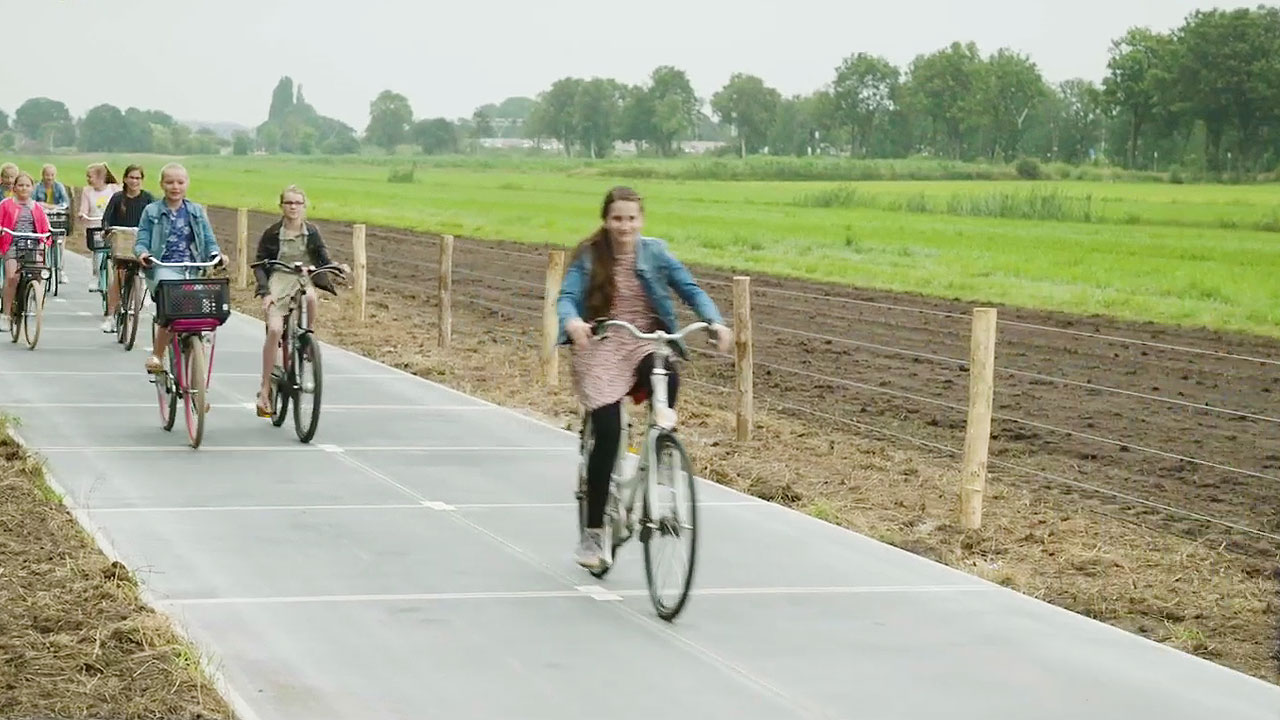
Static
By Marvin Tort

As far back as eight years ago, in 2015, South Korea and the Netherlands both incorporated solar panels in road construction. In particular, both countries have built solar bicycle lanes where dedicated roads for cyclists are lined with solar panels. In the case of Korea, the panels went on top. But in the Netherlands, the panels went to the bottom.
In South Korea, the panels work as a solar-powered roof that shelter cyclists from the sun and rain. At the same time, they generate electricity to power lighting and vehicle charging stations along a 32-kilometer highway with three lanes on each side. The bicycle lane is at the center island of the highway, protected by steel crash barriers. Cyclists use underground tunnels to enter and exit the bike lane.
The six-lane highway runs between Daejeon and Sejong. Although online publication road.cc reports that “it isn’t clear how much cyclists are protected from the noise, pollution, and turbulence by the [solar] pavilion.” Daejeon is South Korea’s fifth largest metropolis, while Sejong is the de facto administrative capital.
The website Interesting Engineering reports that the highway connects Daejon and Sejong “in a much more efficient and safer manner.” But the bike lane has its “drawbacks,” such as “the noise of the highway, potential health issues related to breathing in vehicular fumes and emissions of the fast-moving cars and trucks, and the possibility of a driver hitting the barriers at some point.”
“Therefore, public opinion on the [bike] lane is divided: While some think that it’s a fantastic idea that represents the first move toward making similar commuting-style bike lanes in the future, some think the side of the road would be a better placement,” it adds. “Still, this highlights the potential our cement roads hold.”
The Netherlands, on the other hand, opted to use the solar panels as the bike lane itself, rather than its roof. Website Science Alert refers to the lane as the “energy-harvesting bike path.” It reports, “engineers say the system is working even better than expected, with the 70-meter test bike path generating 3,000 kWh, or enough electricity to power a small household for a year.”
Science Alert notes that the Netherlands was the first country to put the solar road idea into “practice” with the bike path in Krommenie, a town north of Amsterdam. “The solar panels used on the Dutch bike path are sandwiched between glass, silicon rubber, and concrete, and are strong enough to support 12-ton fire trucks without any damage. Each individual panel connects to smart meters, which optimize their output and feed their electricity straight into street lighting, or the grid,” Science Alert reports.
But the project took a lot of work, with engineers reportedly spending five years “creating the system to be durable.” And then more than 150,000 cyclists were asked to test the solar panels by riding ride over them. The panels were said to have been designed to take in as much sunlight as possible, and to also match the life of rooftop solar panels.
And while the Koreans and the Dutch have taken the lead, the Chinese are not far behind. China has constructed a one-kilometer “solar” road in the Shandong province capital city of Jinan. Website Solar.com reports that the road spans 5,875 square meters and covers it with “a top clear concrete layer, a middle solar panel, and a bottom layer of insulation.”
The road is said to generate an estimated one million kWh of electricity annually — which is reportedly enough to provide basic electricity needs to about 800 residences. Website NS Energy reports that the “Chinese government plans to use the electricity created by its solar highway to power streetlights, billboards, and CCTV cameras, as well as to heat the roads surface to melt any snow that gathers on it.”
NS Energy adds, the road “comprises a protective surface layer made of transparent concrete, which can reportedly handle 10-times the pressure of standard asphalt. Beneath that is a middle layer of solar-powered batteries, which generates the road’s electricity, above a waterproof insulation layer to prevent any dampness from the ground below. It’s estimated that roughly 40,000 cars will be able to drive over the solar highway every day, with two lanes to choose from in addition to an emergency lane to help ease congestion.”
Cost, however, is a factor to consider. The China solar highway reportedly costs 90 times more than a regular highway. “Solar roads do have a greater upfront cost than traditional roads,” Solar.com reports. “However, project designers hope that solar roads’ durability will make repaving projects — which are traditionally required every couple of years — unnecessary.”
And, as far as vehicle traction issues go, Solar.com notes that experts believe solar roads are safe since “the surface layer uses a plastic-like substance that actually has more friction than traditional roads.” But solar roads are “less efficient than optimally positioned panels, with only about half of traditional output, due to cars blocking out sunlight.”
And this is where the Korean project, I believe, presents a more compelling example of how to incorporate solar panels in road and highway design. By using the panels on top, as shade or a roof, rather than as the road itself, the panels are optimally positioned to catch sunlight for longer periods. Moreover, regular panels can be used, instead of special panels designed to carry heavy loads.
We are now embarking on a major project to rehabilitate our railways. The work will involve new tracks, trains, and stations. Imagine the potential of that project to make use of as many solar panels as possible at stations, along the side of the tracks, and on train tops. India is already using a solar-powered train, with panels on top, while China’s largest train station, at 68 hectares, got a solar roof.
In the Makati Central Business District, there is a kilometer-long elevated walkway along Dela Rosa St. that is constantly exposed to the sun. And there are lots of building rooftops as well as pedestrian walks and waiting sheds that can be roofed with solar panels. Even large open parking spaces can be roofed or shaded with solar panels.
Solar technology is now available to everybody. The Koreans, the Dutch, and the Chinese showed the way as early as eight years ago. Our policymakers and investors should consider lining roadways or pedestrian walks with solar panels. After all, the Philippines has more sunshine than those countries. More important, that sunshine is free.
Marvin Tort is a former managing editor of BusinessWorld, and a former chairman of the Philippine Press Council